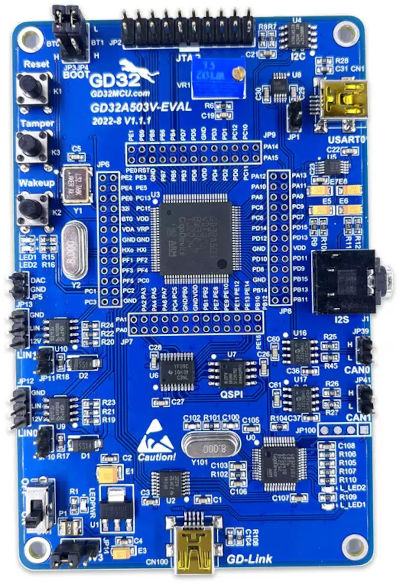GigaDevice GD32A503V-EVAL
Overview
The GD32A503V-EVAL board is a hardware platform that enables design and debug of the GigaDevice A503 Cortex-M4F High Performance MCU.
The GD32A503VD features a single-core ARM Cortex-M4F MCU which can run up to 120-MHz with flash accesses zero wait states, 384kiB of Flash, 48kiB of SRAM and 88 GPIOs.

Hardware
2 user LEDs
2 user push buttons
Reset Button
ADC connected to a potentiometer
1 DAC channels
GD25Q16 2Mib SPI Flash
AT24C02C 2KiB EEPROM
CS4344 Stereo DAC with Headphone Amplifier
GD-Link interface
CMSIS-DAP swd debug interface over USB HID.
2 CAN port(support CAN-FD)
For more information about the GD32A503 SoC and GD32A503V-EVAL board:
Supported Features
The board configuration supports the following hardware features:
Peripheral |
Kconfig option |
Devicetree compatible |
|---|---|---|
EXTI |
||
GPIO |
||
NVIC |
N/A |
|
PWM |
||
SYSTICK |
N/A |
N/A |
USART |
||
PINMUX |
||
ADC |
||
DAC |
||
FMC |
N/A |
|
SPI |
Serial Port
The GD32A503V-EVAL board has 3 serial communication ports. The default port is UART0 at PIN-72 and PIN-73.
Programming and Debugging
Before program your board make sure to configure boot setting and serial port. The default serial port is USART0.
Boot-0 |
Boot-1 |
Function |
|---|---|---|
1-2 |
1-2 |
SRAM |
1-2 |
2-3 |
Bootloader |
2-3 |
Any |
Flash |
Using GD-Link
The GD32A503V-EVAL includes an onboard programmer/debugger (GD-Link) which allow flash programming and debug over USB. There are also program and debug headers J2 and J100 that can be used with any ARM compatible tools.
Build the Zephyr kernel and the Hello World sample application:
west build -b gd32a503v_eval samples/hello_worldRun your favorite terminal program to listen for output. Under Linux the terminal should be
/dev/ttyUSB0. For example:$ minicom -D /dev/ttyUSB0 -o
The -o option tells minicom not to send the modem initialization string. Connection should be configured as follows:
Speed: 115200
Data: 8 bits
Parity: None
Stop bits: 1
To flash an image:
west build -b gd32a503v_eval samples/hello_world west flash
You should see “Hello World! gd32a503v_eval” in your terminal.
To debug an image:
west build -b gd32a503v_eval samples/hello_world west debug
Using ROM bootloader
The GD32A503 MCU have a ROM bootloader which allow flash programming. User
should install GD32 ISP Console software at some Linux path. The recommended
is $HOME/.local/bin.
Build the Zephyr kernel and the Hello World sample application:
west build -b gd32a503v_eval samples/hello_worldEnable board bootloader:
Remove boot-0 jumper
press reset button
To flash an image:
west flash -r gd32isp [--port=/dev/ttyUSB0]Run your favorite terminal program to listen for output. Under Linux the terminal should be
/dev/ttyUSB0. For example:$ minicom -D /dev/ttyUSB0 -o
The -o option tells minicom not to send the modem initialization string. Connection should be configured as follows:
Speed: 115200
Data: 8 bits
Parity: None
Stop bits: 1
Press reset button
You should see “Hello World! gd32a503v_eval” in your terminal.
